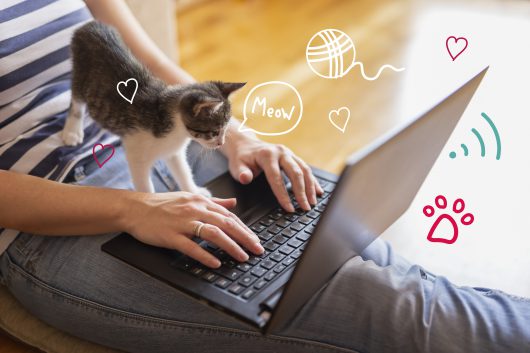Pet First Aid
Emergency situations can arise for your pet at any time. As a pet owner, would you know what to do if your pet required First Aid? It’s understandable to be worried and concerned, and the thought of trying to stay calm while your pet is in pain or discomfort isn’t easy.
It’s always worthwhile swatting up on Pet First Aid just in case something happens…
As a cat or dog owner, there are some things you can do as a Pet First Aid measure prior to seeking advice from your vet. Always remember that pets who are scared or in pain may not react normally, and may not understand that you are trying to help. Even the friendliest dogs can bite in an emergency situation. Be careful, and see a doctor as soon as possible if you do get injured.
Bleeding
If your pet is bleeding, apply pressure directly over the area of excessive bleeding using a clean cloth or towel whilst someone else is driving you to the vets. Paws and ears will bleed a lot however this is rarely a dangerous amount so try not to panic!
If you have bandage material at home then a pressure bandage may be applied to the wound, as long as this is not left in place for more than 30 minutes.
However, if you suspect that your pet has a fracture as well in this area then this isn’t recommended as it could cause more damage.
Wounds
If there’s foreign material, for example sticks, in the wound then please don’t try to remove this as it could make the bleeding worse, or bleeding could start once it’s removed. This type of injury would still require veterinary assistance to safely assess and treat the wound.
Dog bites often cause more tissue damage than is visible from the outside, and are likely to get infected, so even bites that appear minor should be checked by a vet.
If you feel that there are internal organs or muscles visible from a traumatic wound or a surgical wound breakdown, then it’s advisable to cover the area lightly with a clean towel to prevent further infection and to prevent your pet from licking the area.

Fractures
This type of injury needs to be treated as soon as possible by your vet.
Don’t apply a splint as this can increase pain and discomfort for your pet.
Confine your pet as much as possible; if a cat or small dog then placing them in a pet carrier will be ideal.
Objects stuck in the mouth or throat (for example, balls and bones)
You can try removing the foreign material, either via the mouth or by applying gentle pressure upwards behind the jawbone. If you can’t remove or your pets’ gums are turning blue, then you’ll need to seek veterinary guidance as soon as possible.
Burns and scolds
Immediately run cool water over the region for at least five minutes then seek veterinary advice as soon as possible. Please don’t apply creams and ointments, however if you’re unable to get to the vet immediately then you can apply a cold compress to the area. If the burn is deep, cover it lightly with clingfilm as this will keep it clean without sticking.
Ingested possible poison
It’s important to find the packaging of the poison/product so that the vets can assess the best treatment, and ensure you contact the vets as soon as possible to be seen. If you unsure whether treatment is needed, you can contact the Animal Poison Line 24/7 on 01202 509000.
Coat contamination
If the substance is tar or paint, then the first thing to do is prevent your pet from licking it as it may be toxic to them. You can either use a buster collar if you have one to hand or distract your pet from licking until veterinary treatment is sought.
If it is just a small area that’s contaminated, then you may be able to clip the fur away. Never use white spirit or turpentine to remove this as it’s toxic if ingested.
You may be able to remove some substances by bathing with washing up liquid, however if a large area is contaminated then it may be more appropriate to seek veterinary attention.

Emergency situations
The following emergency situations are ones in which veterinary intervention should be sought straight away:
- Respiratory (breathing) distress
- Severe bleeding
- Collapse and unconsciousness
- Rapid abdominal distension
- Unable to urinate – especially male cats
- Sudden onset of neurological problems, for example seizures
- Severe diarrhoea, especially if there is blood
- Severe vomiting, especially if your pet is quieter than normal
- Extreme pain
- Difficulty giving birth
- Road traffic accidents
All the above first aid should only be attempted if you feel it’s possible. Your pet will be distressed, and may not want you to touch them, therefore risking yourself as well as your pet. In this instance then seek veterinary advice and attention as soon as possible.
In all emergency situations, it’s advisable to contact your veterinary practice prior to attending. This is so that they can prioritise emergencies and prepare for your arrival.
All owners should be aware of where the out of hours veterinary practice is as emergencies can occur at any time. If in doubt, then speak to your practice who will be able to provide you with their details including the phone number and address.
You can also read our blog post about what you need to do should your dog get bitten by an Adder snake.
Remember, having pet insurance cover in place will help you with any unexpected vet fees should your pet need treatment.
You might also be interested in…
Get a quote in minutes…

Existing customers
Call now on 0808 164 7999
to discuss your policy with us.
Monday - Friday: 08:00 - 20:00 Saturday: 09:00 - 14:00





 Back
Back
